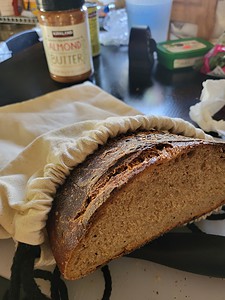
For bread made without preservatives, whole wheat sourdough bread will last surprisingly well − for days if it is not consumed before that. The bread is best on and the day after it is baked and is good if consumed within three days. I toast my slices of sourdough bread a few days after being baked.
To Keep
I often bake two or four loaves at once and store one or more in the freezer for later use. Otherwise, I keep my fresh loaves wrapped in a linen bag inside a breadbox. The slight airy storage will prevent mold from forming, and the sourdough’s crust will help prevent the bread from drying out too soon.
Some folks prefer to slice their bread sooner rather than later and keep it wrapped in a plastic bag or foil in the refrigerator for convenience, especially if they plan to toast it anyway. However, the fridge is not your friend when it comes to saving bread from going stale. Oddly enough, I found that bread hardens and stales faster in my cool refrigerator than in warmer room temperatures. When bread is stored in the fridge, within a plastic bag or wrapped in foil, it may not lose moisture, but the starches harden faster than when kept in a bread box in the kitchen or stored right away in a freezer. Freezing the bread is your friend!
To Refresh
Want to refresh your bread after a few days? Dampen the entire crust generously with a watery mist. Depending on the size of the loaf, place it in an oven preheated to 350°F for 5 to 10 minutes. This will rejuvenate the loaf once, but do not try it twice.
However, refrain from microwaving leftover bread as it will become rubbery. Toast it instead.
To Freeze
As said before, I may store some fresh bakes in the freezer, but only after they have cooled down to ambient room temperatures — typically after 2 hours. Because sourdough is made from only flour, salt, and water — without dairy or eggs, it holds up extremely well in a frozen environment. I even recommend slicing bread in half before freezing it so one can thaw as much or as little as one needs.
I wrap loaves tightly in foil and place them in an airtight, resealable freezer bag — for up to two months. I squeeze out as much air as possible before sealing the bag. Bread is unlikely to stale quickly in the freezer. Naturally, though, I have experienced a loss of quality over time, depending on the bread’s moisture content and how fresh the bread was before going into the freezer.
The main issue to avoid is freezer burn. It is generally caused by food not being securely wrapped in air-tight packaging while stored over longer periods. If large ice crystals develop inside the plastic or foil, the texture or taste of the bread may be compromised. Should the bread start to smell like other items from your freezer during the thawing process — or become crumbly or breaking apart — it likely is past its prime.
To Defrost
Thaw the bread wrapped in foil or in a plastic bag (to keep natural moisture in) at room temperature until it is no longer cold. Then refresh the bread as described above.
If defrosting slices, as opposed to an entire or partial loaf, pop them into a toaster after they reach a normal temperature. As with other foods, avoid refreezing bread to avoid further changes in texture and taste.
Desperation Defrost
Preheat oven to 350° F, remove unthawed bread from the freezer bag, and wrap and bake in foil for 15 to 30 minutes, depending on the loaf size.
Enjoy…